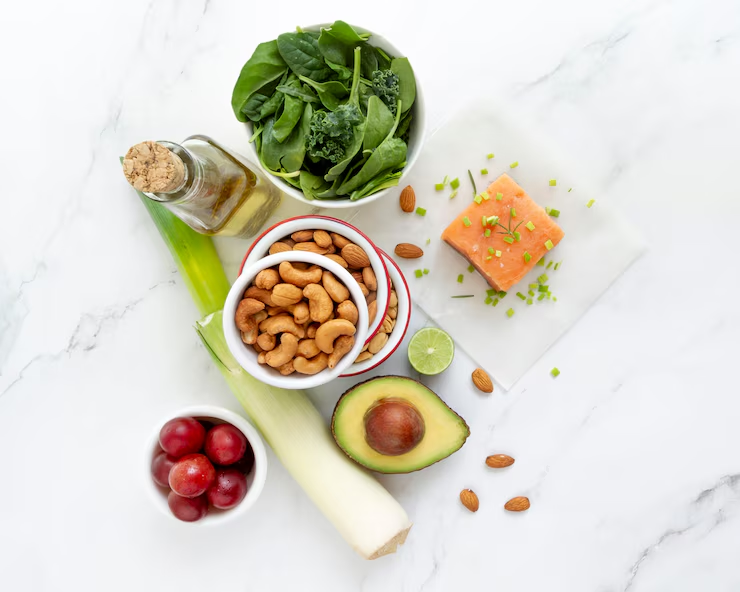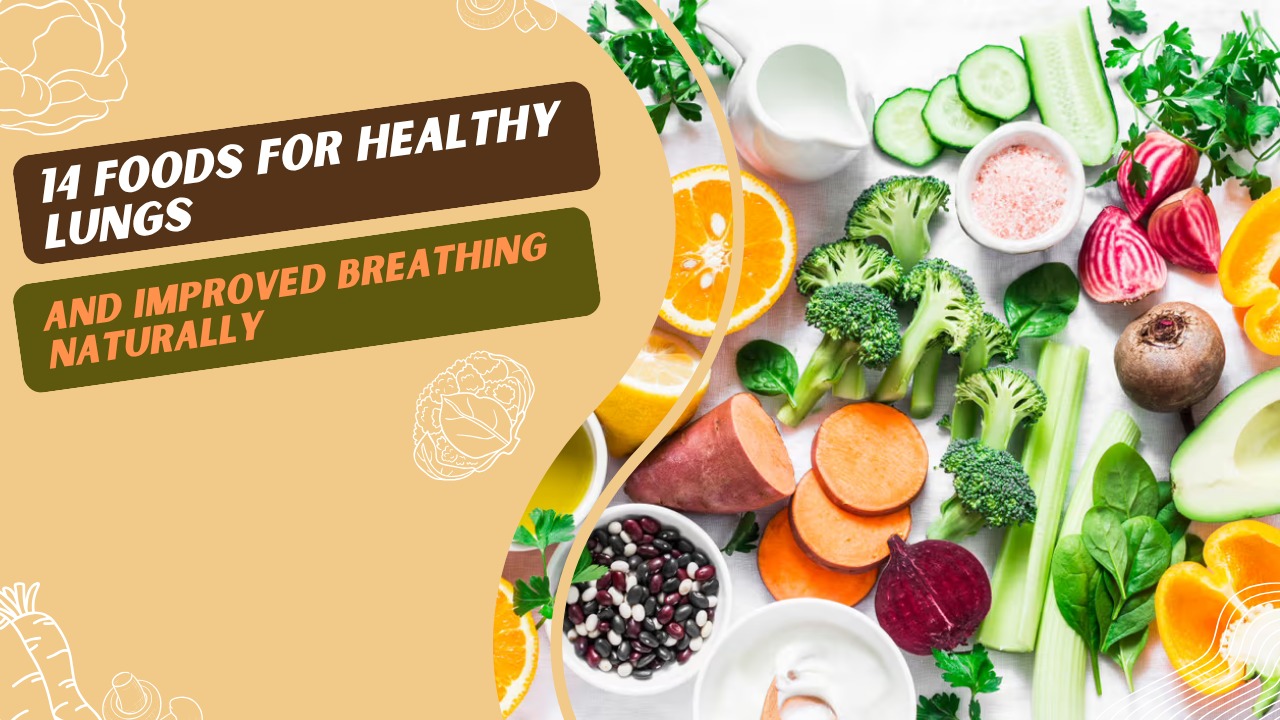14 Foods for Healthy Lungs and Improved Breathing can make a significant difference in how efficiently your respiratory system functions. Your lungs do more than just support breathing—they filter toxins, regulate pH, and fuel your body’s cells with oxygen. While avoiding smoke and pollution is crucial, nutrition also plays a powerful role in lung protection and repair.
Research shows that certain foods rich in antioxidants, anti-inflammatory compounds, and essential vitamins can help reduce lung inflammation, clear airways, and improve breathing efficiency. From leafy greens and berries to garlic and turmeric, incorporating these items into your daily diet supports lung strength and long-term respiratory health.
In this guide, we’ll highlight 14 foods for healthy lungs and improved breathing, explain how diet impacts lung function, and provide simple tips and meal ideas. Whether you’re managing a condition or just want to breathe better every day, these food-based strategies can be your first breath of fresh air.

How Your Lungs Work & Why Diet Matters
Anatomy & Function: Lungs consist of a complex network of airways (bronchi, bronchioles) ending in microscopic sacs (alveoli) where gas exchange occurs. Their primary tasks: deliver oxygen and remove carbon dioxide. They’re also a first line of defense against pathogens and pollutants, thanks to cilia, mucus, and immune cells.
Common Stressors: Air pollution (PM2.5, ozone), cigarette smoke, allergens and infections all challenge lung integrity. Over time, chronic inflammation and oxidative stress can damage airway lining, reduce elasticity, or impair immune response, contributing to bronchitis, asthma, COPD, and even reduced exercise capacity.
Role of Nutrition
Antioxidants neutralize free radicals created by pollutants and inflammation.
Omega‑3 fats reduce inflammatory signaling and may widen airways.
Vitamins/minerals such as vitamin C, E, A, D, magnesium and selenium support immune defense and repair.
Phytonutrients found in fruits, vegetables and spices modulate inflammation and protect tissue integrity.
Together, diet and lifestyle play complementary roles in promoting lung resilience, reducing symptom burden, and improving breathing.
Foods for Lung Health & Why They Matter
Fatty Fish (Salmon, Mackerel, Sardines, Trout)
Key nutrients: Omega‑3 EPA/DHA, protein
Their anti‑inflammatory effects reduce airway irritation and improve asthma symptoms
Studies show omega‑3 supplementation may enhance lung function in asthma and inflammatory lung diseases
How to use: Grill salmon with lemon & herbs; have sardines on salad; bake trout with garlic‑dill
Leafy Greens (Spinach, Kale, Collards, Swiss Chard)
Key nutrients: Vitamins A, C, K, magnesium, folate, antioxidants
Vitamin A supports epithelial tissue of lungs; C protects against oxidative damage
Magnesium aids bronchodilation—helpful for asthma
How to use: Add spinach to omelets, juice, smoothies; make kale salad with citrus and nuts
Berries (Blueberries, Strawberries, Raspberries)
Key nutrients: Anthocyanins, vitamin C, ellagic acid
Rich in antioxidants that guard against nitrogen dioxide and ozone damage
May reduce lung inflammation and support alveolar integrity
How to use: Add to yogurt, oatmeal, or blend into antioxidant smoothies
Citrus Fruits (Oranges, Grapefruit, Lemons, Limes)
Key nutrients: Vitamin C, flavonoids
Vitamin C supports immune function, essential for respiratory health
Flavonoids may reduce asthma attacks and wheezing
How to use: Drink water infused with lemon, enjoy grapefruit with meals, snack on clementines
Cruciferous Vegetables (Broccoli, Brussels Sprouts, Cabbage, Cauliflower)
Key nutrients: Sulforaphane, isothiocyanates, fiber, vitamins
Sulforaphane induces phase‑II detox enzymes, aiding in pollutant metabolism
Associated with higher lung function and lower COPD risk
How to use: Roast broccoli with olive oil, sauté cabbage in stir‑fries, steam cauliflower
Nuts & Seeds (Walnuts, Flaxseeds, Chia Seeds)
Key nutrients: Omega‑3 ALA, vitamin E, magnesium
Omega‑3 ALA converts to EPA/DHA, supporting anti‑inflammatory pathways
Vitamin E protects lung membranes from oxidative stress
How to use: Sprinkle flaxseed on cereal, blend chia seeds into pudding, snack on walnuts
Tomatoes
Key nutrients: Lycopene, vitamin C, potassium
Lycopene has antioxidant, anti‑inflammatory effects that may benefit lung tissue
Observational studies link higher tomato/lycopene intake with better pulmonary function
How to use: Enjoy fresh tomato salads, tomato‑based sauces, or roasted tomatoes
Turmeric
Key nutrient: Curcumin
Potent anti‑inflammatory—may improve lung function and reduce airway inflammation
Animal studies show it attenuates pulmonary fibrosis, asthma, and COPD‑related inflammation
How to use: Add turmeric powder to soups, smoothies, rice dishes, and “golden milk” lattes
Garlic & Onions
Key nutrients: Allicin, quercetin, sulfur compounds
Act as natural anti‑inflammatory and antimicrobial agents
May ease congestion and support lung immunity
How to use: Incorporate raw garlic in salad dressings, sauté onions in cooking, season liberally
Green Tea
Key nutrients: EGCG, polyphenols, L‑theanine
EGCG helps reduce airway inflammation and allergic response
Green tea may improve antioxidant defenses in lung tissue
How to use: Sip 2–4 cups a day; add mint or lemon for flavor
Apples
Key nutrients: Quercetin, fiber, vitamin C
High intake is associated with slower decline in lung function
Quercetin acts as a natural bronchodilator and anti‑inflammatory agent
How to use: Eat raw apples, add to salads, bake into oatmeal
Avocados
Key nutrients: Monounsaturated fats, vitamin E, glutathione precursors
Healthy fats support cell membrane repair in lung tissue
Vitamin E and glutathione work synergistically to neutralize oxidative stress
How to use: Spread on toast, incorporate into salsa, use in smoothies
Bell Peppers (Red, Yellow, Orange)
Key nutrients: Vitamin C, carotenoids (beta‑carotene, lutein), polyphenols
Exceptional source of antioxidants for every bite
May reduce lung inflammation and support antioxidant enzyme activity
How to use: Slice raw peppers for snacks, roast or grill into fajitas or salads
Beets
Key nutrients: Nitrates, betalains, folate, potassium
Dietary nitrates convert to nitric oxide, a vasodilator that improves blood flow
Enhanced circulation may support oxygen delivery and respiratory performance
How to use: Juice beets, roast them in salads, blend into soups and dips
High intake is associated with slower decline in lung function
Proven Tips to Maximize Lung Function
Stay Hydrated
Staying hydrated is essential for keeping lung passages clear and efficient. Water thins mucus, making it easier for your lungs to expel irritants and pathogens. This also supports the cilia—tiny hair-like structures in the airways that trap and move debris out of your respiratory tract. Aim for 2–3 liters of water daily, and even more if you’re active or live in a dry environment.

Hydration becomes even more vital when you’re exposed to pollutants or allergens, as these can lead to thicker mucus. Drinking enough fluids ensures smoother airflow and better oxygen exchange, especially during physical exertion or when recovering from respiratory illnesses. Herbal teas and broths also count toward your fluid intake.
Along with proper hydration, consider including 14 foods for healthy lungs and improved breathing in your diet. Water-rich foods like cucumbers, citrus fruits, and berries not only hydrate but also offer antioxidants that further support lung health.
Why It Helps: Water is essential for thinning the mucus in your airways, which makes it easier to clear through coughing or natural cilia action (tiny hair-like structures that move mucus out of the lungs). Proper hydration keeps your respiratory tract moist, reducing irritation and promoting easier breathing.
Recommended Intake: Aim for 2–3 liters per day, more if you’re physically active or live in a hot or dry climate.
Benefits:
✅ Thins mucus for easier clearance
✅ Improves cilia function in the lungs
✅ Helps reduce coughing and chest congestion
✅ Prevents dry throat and airway irritation
Practice Respiratory Exercises
Practicing daily respiratory exercises can dramatically enhance your lung capacity and efficiency. Diaphragmatic breathing, also called belly breathing, strengthens the diaphragm and helps reduce the effort required to breathe. Practicing for 10–15 minutes daily can lead to improved oxygen exchange.
Pursed-lip breathing is another simple yet powerful technique. By slowing the exhalation process, it reduces breathlessness and improves airflow, especially in people with chronic respiratory conditions. It’s particularly useful during moments of physical exertion or anxiety.
These exercises work best when supported by a lung-friendly diet. Incorporate 14 foods for healthy lungs and improved breathing such as leafy greens, apples, turmeric, and ginger. These foods reduce inflammation and support overall respiratory function, complementing the physical benefits of breathing techniques.
Why It Helps: Breathing exercises train your lungs to work more efficiently and strengthen your respiratory muscles, including the diaphragm. They also reduce stress and help manage conditions like asthma or COPD.
Techniques to Try:
Diaphragmatic Breathing (Belly Breathing):
Increases lung capacity and promotes deeper oxygen intake.
Pursed-Lip Breathing: Slows breathing rate, relieves shortness of breath, and improves oxygen exchange.
Incentive Spirometry: Often used post-surgery to expand the lungs and prevent pneumonia.
Benefits:
✅ Strengthens respiratory muscles
✅ Improves oxygen intake and delivery
✅ Reduces anxiety and shortness of breath
✅ Increases lung capacity and endurance
Regular Exercise & Cardio
Physical activity plays a crucial role in enhancing lung strength and endurance. Exercises like walking, jogging, cycling, or swimming improve oxygen circulation and promote elasticity in the lungs. Target at least 150 minutes of moderate cardio weekly for optimal benefits.

High-intensity interval training (HIIT) can further elevate your lung capacity. These bursts of intense effort train your lungs to handle rapid shifts in oxygen demand, which improves respiratory efficiency over time. Always warm up and cool down to support lung recovery.
Pair your exercise routine with 14 foods for healthy lungs and improved breathing to boost results. Nutrient-rich foods like fatty fish, garlic, citrus fruits, and broccoli support muscle repair and reduce exercise-induced inflammation, creating a powerful synergy between fitness and lung nutrition.
Why It Helps: Physical activity enhances your body’s oxygen use, improves cardiovascular efficiency, and strengthens respiratory muscles. It also helps in clearing excess mucus and reducing inflammation throughout the body.
Ideal Routine:
150 minutes of moderate exercise/week (e.g., walking, swimming, cycling)
Include HIIT (High-Intensity Interval Training) to boost lung efficiency
Benefits:
✅ Strengthens lung capacity and elasticity
✅ Improves oxygen utilization in the body
✅ Helps control weight and inflammation
✅ Reduces breathlessness during everyday activities
Minimize Indoor Pollutants
Improving indoor air quality is vital for protecting lung health. Everyday household activities like cooking, cleaning, or using air fresheners can release harmful irritants. Ensuring good ventilation, especially in kitchens and bathrooms, helps disperse these pollutants.
Avoid synthetic air fresheners, scented candles, and aerosol sprays as they often emit volatile organic compounds (VOCs) that irritate the lungs. Use non-toxic or natural cleaning products and keep indoor humidity between 30–50% to prevent mold and bacteria growth.
Support your lungs further by eating 14 foods for healthy lungs and improved breathing. Antioxidant-rich options like green tea, berries, and cruciferous vegetables can help your lungs detoxify from indoor pollutants, offering natural protection from long-term damage.
Why It Helps: Indoor air can be more polluted than outdoor air. Household cleaners, smoke, mold, and fragrances can irritate the lungs and cause chronic issues. Keeping your indoor air clean protects your lungs, especially if you have asthma or allergies.
How to Reduce Indoor Irritants:
Use natural or non-toxic cleaners
Ensure proper ventilation while cooking
Maintain 30–50% humidity to prevent mold
Avoid synthetic air fresheners, scented candles, and incense
Benefits:
✅ Reduces risk of respiratory irritation and asthma flares
✅ Lowers chances of developing chronic respiratory conditions
✅ Supports better sleep and breathing indoors
✅ Promotes long-term lung tissue health
Quit Smoking & Avoid Secondhand Smoke
There is no greater step for lung health than quitting smoking. Smoking damages the lung tissues, impairs oxygen exchange, and increases the risk of chronic respiratory diseases. Stopping smoking can begin to reverse some of these effects over time.
Even if you don’t smoke, secondhand smoke can be equally harmful. It contributes to inflammation and narrows the airways, making breathing more difficult. Surround yourself with smoke-free environments and avoid social settings that expose you to cigarette smoke.
Combine smoking cessation efforts with 14 foods for healthy lungs and improved breathing. Foods like turmeric, ginger, and tomatoes are known for their anti-inflammatory and detoxifying properties, helping repair lung tissue and combat oxidative stress caused by smoking.
Why It Helps: Cigarette smoke is one of the leading causes of lung diseases like COPD, emphysema, and lung cancer. Even exposure to secondhand smoke causes long-term damage to lung tissue. Quitting smoking is the most effective way to improve lung function.
Support Methods:
Nicotine replacement therapy
Smoking cessation programs
Behavioral counseling
Mobile apps and helplines
Benefits:
✅ Stops further lung damage and allows healing
✅ Reduces risk of lung cancer, COPD, and heart disease
✅ Improves lung capacity and oxygen delivery within weeks
✅ Increases energy levels and exercise tolerance
Optimize Air Quality
Outdoor and indoor air quality greatly affect lung function. Monitor air pollution levels—especially PM2.5 and ozone—using reliable apps or websites. On poor air days, stay indoors, close windows and doors, and avoid physical exertion outside.
Investing in a good air purifier with a HEPA filter or smart sensor can help cleanse your indoor air. Avoid vacuuming without a HEPA-filter vacuum and steer clear of using wood-burning stoves or open fires, which release fine particles.
To strengthen your body against polluted air, nourish yourself with 14 foods for healthy lungs and improved breathing. These include apples, green leafy vegetables, walnuts, and oily fish, all of which provide protective nutrients like omega-3s, flavonoids, and vitamin C.
Why It Helps: Poor outdoor air quality—due to smog, vehicle exhaust, or wildfires—can aggravate asthma, allergies, and chronic lung diseases. Monitoring and limiting exposure to pollutants helps reduce inflammation and oxidative stress in the lungs.
Tips to Improve Exposure:
Use air quality apps (check PM2.5 and ozone levels)
Stay indoors during high-pollution days
Use HEPA air purifiers in your home
Close windows and doors on smoggy or smoky days
Benefits:
✅ Reduces lung inflammation and irritation
✅ Protects against asthma triggers and allergic reactions
✅ Enhances breathing quality and energy levels
✅ Slows down respiratory aging from environmental toxins
Prioritize Sleep & Rest
Adequate sleep supports overall health, including your lungs. During deep sleep, the body undergoes tissue repair and immune regulation. Aim for 7–9 hours of restful sleep each night in a clean, well-ventilated room.

Sleep disturbances, like sleep apnea or allergies, can affect breathing patterns and oxygen supply. Using hypoallergenic bedding and air purifiers in the bedroom helps ensure better air quality and reduces nighttime respiratory strain.
Adding 14 foods for healthy lungs and improved breathing to your evening meals or snacks—such as almonds, bananas, or herbal teas—can help calm the nervous system and support respiratory repair overnight. A well-rested body heals and breathes more efficiently.
Why It Helps: During deep sleep, the body repairs tissues—including those in the lungs. Sleep also supports immune function, hormone balance, and lowers inflammation, all of which are essential for healthy breathing.
Ideal Routine:
Maintain a regular sleep schedule (7–9 hours/night)
Keep bedroom air clean and allergen-free
Use a humidifier if air is dry
Benefits:
✅ Promotes lung tissue repair and recovery
✅ Enhances immune defense against infections
✅ Reduces inflammation and fatigue
✅ Improves breathing rhythm and mental clarity
Boost Immunity & Get Vaccinated
A strong immune system is your first defense against lung infections like the flu, COVID-19, and pneumonia. Stay up to date with recommended vaccinations, including annual flu shots and other respiratory-related immunizations.
Practicing good hygiene—like frequent handwashing, avoiding sick individuals, and disinfecting high-touch surfaces—helps reduce the risk of illness. Adequate rest, stress management, and hydration further support immune resilience.
Nutrition plays a key role in immune support. Focus on 14 foods for healthy lungs and improved breathing such as citrus fruits, bell peppers, mushrooms, and vitamin D-rich foods like eggs and fortified dairy. These nourish the immune system while fortifying lung tissues against infection.
Why It Helps: Lung infections (e.g., flu, COVID-19, pneumonia) can cause serious complications. Strengthening your immune system and staying current on vaccinations protects your lungs from acute damage and long-term scarring.
Supportive Actions:
Eat nutrient-rich foods (vitamin C, zinc, antioxidants)
Stay active and hydrated
Get recommended vaccines (flu, pneumonia, COVID-19, RSV if eligible)
Practice good hand hygiene and avoid sick contacts
Benefits:
✅ Reduces risk of lung infections and hospitalizations
✅ Maintains lung function during cold/flu seasons
✅ Prevents disease progression in chronic lung conditions
✅ Supports long-term respiratory health
Sample Daily Meal Plan Incorporating 14 Lung‑Healthy Foods
Here’s your meal plan presented in a table format with the keyword 14 foods for healthy lungs and improved breathing naturally integrated:
| Meal | Items | 14 Foods for Healthy Lungs and Improved Breathing Featured |
|---|---|---|
| Breakfast | Green smoothie with spinach, avocado, chia seeds, berries, banana (blended with water or almond milk) Green tea (10 oz) | Spinach, avocado, chia seeds, berries – all part of the 14 foods for healthy lungs and improved breathing |
| Mid-Morning Snack | Apple with a handful of walnuts | Apple and walnuts – included in the 14 foods for healthy lungs and improved breathing |
| Lunch | Mixed salad with kale, red bell pepper, tomatoes, grilled salmon, olive oil/lemon-garlic dressing Water with lemon | Kale, bell pepper, tomatoes, salmon, garlic, lemon – all from the 14 foods for healthy lungs and improved breathing |
| Afternoon Boost | Golden turmeric latte Sliced strawberries | Turmeric and strawberries – key picks from the 14 foods for healthy lungs and improved breathing |
| Dinner | Grilled mackerel Roasted broccoli and cauliflower Beet-feta salad with cilantro & citrus drizzle Garlic/onion stir-fry or bread | Mackerel, broccoli, cauliflower, garlic, onions – all part of the 14 foods for healthy lungs and improved breathing |
| Evening Treat | Herb-steeped green tea Fresh orange slices | Green tea and oranges – two more from the 14 foods for healthy lungs and improved breathing |
This sample plan makes it easy to incorporate the 14 foods for healthy lungs and improved breathing into a full day of nourishing meals.
Conclusion

Strong, resilient lungs are built through a powerful combination of nutrition and lifestyle. A targeted diet rich in 14 foods for healthy lungs and improved breathing—such as berries, garlic, citrus fruits, and leafy greens—can significantly enhance your respiratory wellness. These foods provide antioxidants, anti-inflammatory nutrients, and essential vitamins that support lung tissue, reduce oxidative stress, and improve oxygen flow.
In addition to nutrition, lifestyle plays a critical role. Regular physical activity, smart breathing techniques like diaphragmatic or pursed-lip breathing, and quitting smoking are proven strategies to boost lung capacity and efficiency. Clean indoor air, good ventilation, and proper rest are just as vital to protect your lungs daily.
By making small but consistent changes—eating cruciferous vegetables, fatty fish, turmeric, and fresh produce; hydrating well; and guarding against pollution—you promote stronger lungs and better breathing. Embracing these 14 foods for healthy lungs and improved breathing can transform every breath into a step toward vibrant health.
FAQs
Q1. What are the 14 foods for healthy lungs and improved breathing ?
The 14 foods for healthy lungs and improved breathing include fatty fish (like salmon and mackerel), leafy greens (spinach, kale), berries, apples, citrus fruits, turmeric, garlic, onions, red bell peppers, broccoli, cauliflower, walnuts, and chia seeds. These foods are rich in antioxidants, omega-3s, vitamins C, E, and flavonoids that support lung function, reduce inflammation, and improve breathing capacity.
Q2. How do these 14 foods improve lung health ?
The 14 foods for healthy lungs and improved breathing help by reducing oxidative stress, fighting inflammation, and strengthening immune function. For example, garlic and onions contain compounds that open airways, berries protect lung tissue with antioxidants, and citrus fruits boost vitamin C for respiratory defense. Together, they support easier, deeper, and healthier breathing.
Q3. Can I eat all 14 foods in a single day ?
Yes! With proper planning, you can incorporate all 14 foods for healthy lungs and improved breathing into daily meals. For example, start your day with a spinach-berry smoothie, snack on an apple with walnuts, enjoy a salad with kale, red bell peppers, and salmon for lunch, and include garlic, broccoli, and turmeric at dinner.
Q4. Are these lung-healthy foods safe for everyone ?
Generally, the 14 foods for healthy lungs and improved breathing are safe for most people. However, individuals with allergies (e.g., nuts or fish) or medical conditions should consult a healthcare provider before making significant dietary changes. The goal is to personalize lung support based on your body’s needs.
Q5. Can food alone improve lung function, or are other steps needed ?
While the 14 foods for healthy lungs and improved breathing are essential, a complete lung health plan includes more than diet. Exercise, proper hydration, avoiding smoking, and protecting against pollution are equally important. Combined with these foods, such habits lead to better breathing, endurance, and overall lung strength.


